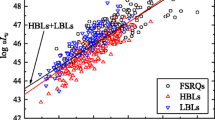Abstract
In a two-component model, the total observed emissions are the sum of two contributions, namely a beamed one and an unbeamed one. The observed beamed emissions from a relativistic jet are strongly boosted due to the beaming effect while the observed unbeamed emissions are the same as that in the co-moving frame. In the X-ay band, it is hard to separate the beamed and the unbeamed emissions from observations. However, it is interesting to investigate the X-ray emissions applying the two-component model as in Kembhavi (Mon. Not. R. Astron. Soc. 264:683, 1993). In this work, a sample of 397 blazars with available X-ray data and radio core-dominance parameters are compiled and the method proposed by Kembhavi et al is adopted to separate the two components in the X-ray emissions, then we also discuss the difference between BL Lac objects and FSRQs. Our results show that: (1) The beamed emissions dominate the X-ray emissions. (2) The averaged X-ray core-dominance parameter in BL Lacertae objects is greater than that in FSRQs. (3) A correlation between X-ray spectral index and X-ray core-dominance parameter is obtained, which supports the unified scheme of BL Lac objects, FR type I galaxies and FR type II with galaxy morphology, FSRQs unified with FR type two quasars.










Similar content being viewed by others
References
Abdo, A.A., Ackermann, M., Agudo, I., et al.: Astrophys. J. 716, 30 (2010). https://doi.org/10.1088/0004-637X/716/1/30
Antonucci, R.: Annu. Rev. Astron. Astrophys. 31, 473 (1993). https://doi.org/10.1146/annurev.aa.31.090193.002353
Bai, J.M., Lee, M.G.: Astrophys. J. 548, 244 (2001). https://doi.org/10.1086/318695
Browne, I.W.A.: Mon. Not. R. Astron. Soc. 204, 23P (1983). https://doi.org/10.1093/mnras/204.1.23P
Browne, I.W.A., Murphy, D.W.: Mon. Not. R. Astron. Soc. 226, 601 (1987). https://doi.org/10.1093/mnras/226.3.601
Comastri, A., Fossati, G., Ghisellini, G., et al.: Astrophys. J. 480, 534 (1997). https://doi.org/10.1086/303986
Dermer, C.D., Finke, J.D., Krug, H., et al.: Astrophys. J. 692, 32 (2009). https://doi.org/10.1088/0004-637X/692/1/32
Fan, J.H.: Astrophys. J. Lett. 585, L23 (2003a). https://doi.org/10.1086/374033
Fan, J.H., Zhang, J.S.: Astron. Astrophys. 407, 899 (2003b). https://doi.org/10.1051/0004-6361:20030896
Fan, J.-H., Romero, G.E., Wang, Y.-X., et al.: Chin. J. Astron. Astrophys. 5, 457 (2005). https://doi.org/10.1088/1009-9271/5/5/003
Fan, J.-H., Hua, T.-X., Yuan, Y.-H., et al.: Publ. Astron. Soc. Jpn. 58, 945 (2006). https://doi.org/10.1093/pasj/58.6.945
Fan, J.-H., Yuan, Y.-H., Liu, Y., et al.: Publ. Astron. Soc. Jpn. 60, 1217 (2008). https://doi.org/10.1093/pasj/60.5.1217
Fan, J.-H., Yang, J.-H., Tao, J., et al.: Publ. Astron. Soc. Jpn. 62, 211 (2010). https://doi.org/10.1093/pasj/62.2.211
Fan, J.-H., Yang, J.-H., Pan, J., et al.: Res. Astron. Astrophys. 11, 1413 (2011). https://doi.org/10.1088/1674-4527/11/12/004
Fan, J.H., Yang, J.H., Liu, Y., et al.: Astrophys. J. Suppl. Ser. 226, 20 (2016). https://doi.org/10.3847/0067-0049/226/2/20
Fanaroff, B.L., Riley, J.M.: Mon. Not. R. Astron. Soc. 167, 31P (1974). https://doi.org/10.1093/mnras/167.1.31P
Finke, J.D., Dermer, C.D., Böttcher, M.: Astrophys. J. 686, 181 (2008). https://doi.org/10.1086/590900
Ghisellini, G., Padovani, P., Celotti, A., et al.: Astrophys. J. 407, 65 (1993). https://doi.org/10.1086/172493
Kembhavi, A.: Mon. Not. R. Astron. Soc. 264, 683 (1993). https://doi.org/10.1093/mnras/264.3.683
Lucchini, M., Tavecchio, F., Ghisellini, G.: Mon. Not. R. Astron. Soc. 466, 4299 (2017). https://doi.org/10.1093/mnras/stw3316
Maraschi, L., Ghisellini, G., Celotti, A.: Astrophys. J. Lett. 397, L5 (1992). https://doi.org/10.1086/186531
Neyman, J.: Skand. Aktuarietidskr. 20, 149 (1937). https://doi.org/10.1525/9780520327016-023
Nieppola, E., Tornikoski, M., Valtaoja, E.: Astron. Astrophys. 445, 441 (2006). https://doi.org/10.1051/0004-6361:20053316
Orr, M.J.L., Browne, I.W.A.: Mon. Not. R. Astron. Soc. 200, 1067 (1982). https://doi.org/10.1093/mnras/200.4.1067
Padovani, P.: Astron. Astrophys. 256, 399 (1992)
Paliya, V.S., Sahayanathan, S., Stalin, C.S.: Astrophys. J. 803, 15 (2015). https://doi.org/10.1088/0004-637X/803/1/15
Pei, Z.-Y., Fan, J.-H., Bastieri, D., et al.: Res. Astron. Astrophys. 19, 070 (2019). https://doi.org/10.1088/1674-4527/19/5/70
Pei, Z., Fan, J., Bastieri, D., et al.: Sci. China, Phys. Mech. Astron. 63, 259511 (2020a). https://doi.org/10.1007/s11433-019-1454-6
Pei, Z.-Y., Fan, J.-H., Bastieri, D., et al.: Res. Astron. Astrophys. 20, 025 (2020b). https://doi.org/10.1088/1674-4527/20/2/25
Pei, Z., Fan, J., Yang, J., et al.: Proc. Astron. Soc. Aust. 37, e043 (2020c). https://doi.org/10.1017/pasa.2020.30
Pei, Z., Fan, J., Yang, J., et al.: Publ. Astron. Soc. Pac. 132, 114102 (2020d). https://doi.org/10.1088/1538-3873/abb78f
Sikora, M., Begelman, M.C., Rees, M.J.: Astrophys. J. 421, 153 (1994). https://doi.org/10.1086/173633
Urry, C.M., Padovani, P.: Publ. Astron. Soc. Pac. 107, 803 (1995). https://doi.org/10.1086/133630
Urry, C.M., Shafer, R.A.: Astrophys. J. 280, 569 (1984). https://doi.org/10.1086/162027
Wills, B.J., Wills, D., Breger, M., et al.: Astrophys. J. 398, 454 (1992). https://doi.org/10.1086/171869
**e, G.Z., Zhang, Y.H., Fan, J.H., et al.: Astron. Astrophys. 278, 6 (1993)
Yang, J-h., Fan, J.-h., Zhang, Y.-l., et al.: Chin. Astron. Astrophys. 43, 23 (2019). https://doi.org/10.1016/j.chinastron.2019.02.009
Ye, X.-H., Fan, J.-H.: Publ. Astron. Soc. Jpn. 73, 775 (2021). https://doi.org/10.1093/pasj/psab039
Zhang, C., Fan, J.: Sci. China, Phys. Mech. Astron. 52, 1434 (2009). https://doi.org/10.1007/s11433-009-0183-1
Acknowledgements
We thank the anonymous referee for the comments, which has helped us to improve our manuscript.
Funding
The work is partially supported by the National Natural Science Foundation of China (NSFC U2031201, NSFC 11733001, U2031112), Guangdong Major Project of Basic and Applied Basic Research (Grant No. 2019B030302001). We also acknowledge the science research grants from the China Manned Space Project with NO. CMS-CSST-2021-A06, and the supports for Astrophysics Key Subjects of Guangdong Province and Guangzhou City. The work is also supported by Guangzhou University (YM2020001).
Author information
Authors and Affiliations
Contributions
Zhiyuan Pei, Hubing **ao contributed to the study conception and design. Data collection and analysis were performed by **angtao Zeng and Zhuang Zhang. Junhui Fan proposed to do this research and gave the structure and the content of the manuscript. The first draft of the manuscript was written by **angtao Zeng and all authors commented on previous versions of the manuscript. All authors read and approved the final manuscript.
Ethics declarations
Conflict of Interest
The authors declare no conflicts of interest.
Additional information
Publisher’s Note
Springer Nature remains neutral with regard to jurisdictional claims in published maps and institutional affiliations.
Supplementary Information
Rights and permissions
About this article
Cite this article
Zeng, X., Zhang, Z., Pei, Z. et al. Two-component model of the X-ray emissions for \(\mathit {Fermi}\)-LAT selected blazars. Astrophys Space Sci 367, 36 (2022). https://doi.org/10.1007/s10509-022-04064-3
Received:
Accepted:
Published:
DOI: https://doi.org/10.1007/s10509-022-04064-3




